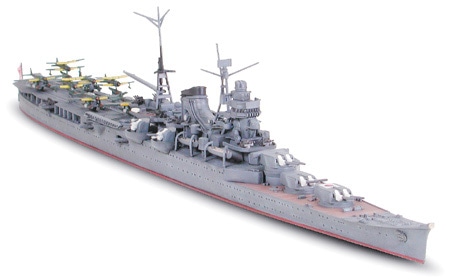1/700 Mogami Aircraft Carrying Cruiser
26,95€
Only 1 left in stock

*Please check our Privacy Policies to see how to we use your personal data.
*Por favor revisa nuestra Política de Privacidad para ver como tratamos tus datos personales
About the Aircraft Carrying Cruiser Mogami
Tamiya presents the unique Japanese Navy Aircraft Carrying Cruiser Mogami, which was able to carry eleven hydroplanes in the second half of the Pacific war. She was equipped with 15.5cm cannons mounted on 5 dual gun turrets and was completed on July 1935 as the 1st ship of the “Mogami class” cruisers. The main guns were replaced during 1939/40 with dual 20cm gun turrets transforming these light cruisers into heavy cruisers. In the first half of the WWII, the Mogami took part in the Malay landing operation and the battle of Sunda Strait. However, during the battle of Midway in June 1942, the Mogami violently crushed into the port side of the Mikuma. During repairs, the rear part of the ship was equipped with a flight deck that could fit eleven planes and ten 25mm triple gun anti-aircraft batteries were added. The Mogami participated in the Battle of the Mariana in June 1944 and in October 1944, she fought against enemy fleet at night in the Battle of Leyte. After sustaining heavy fire from the US fleet, the Mogami erupted in flames, and the decision was made to abandon ship and scuttle it with torpedoes. The Mogami disappeared into the depths of the Mindanao Sea.
About the Model
★Japanese Aircraft Carrying Cruiser Mogami plastic assembly kit. ★1/700 scale, Overall length: 286.5mm, width: 36.5mm. The compact bridge structure and particular shape of funnel are reproduced down to finest detail. ★The layout of the rear part flight deck with rails and turntables replica is based on most recent references. ★The main turrets can rotate after completion via polycap. ★Equipment such as armament including 12.7cm gun turrets or triple tube torpedo launchers, main mast, aircraft crane and catapults are sharply reproduced.
Sobre el crucero portaaviones Mogami
Tamiya presenta el singular crucero portaaviones Mogami de la Armada japonesa, capaz de transportar once hidroaviones en la segunda mitad de la guerra del Pacífico. Estaba equipado con cañones de 15,5 cm montados en 5 torretas de doble cañón y se completó en julio de 1935 como el primer buque de la «clase Mogami» cruceros. Los cañones principales se sustituyeron en 1939/40 por torretas dobles de 20 cm que transformaron estos cruceros ligeros en pesados. En la primera mitad de la Segunda Guerra Mundial, el Mogami participó en la operación de desembarco en Malasia y en la batalla del estrecho de Sunda. Sin embargo, durante la batalla de Midway en junio de 1942, el Mogami chocó violentamente contra la banda de babor del Mikuma. Durante las reparaciones, se equipó la parte trasera del buque con una cubierta de vuelo en la que cabían once aviones y se añadieron diez baterías antiaéreas de tres cañones de 25 mm. El Mogami participó en la Batalla de las Marianas en junio de 1944 y en octubre de 1944 luchó de noche contra la flota enemiga en la Batalla de Leyte. Tras recibir un intenso fuego de la flota estadounidense, el Mogami estalló en llamas y se tomó la decisión de abandonar el barco y hundirlo con torpedos. El Mogami desapareció en las profundidades del mar de Mindanao.
Sobre el modelo
★Japanese Aircraft Carrying Cruiser Mogami kit de montaje de plástico. Escala ★1/700, Longitud total: 286,5mm, anchura: 36,5mm. La estructura compacta del puente y la forma particular de la chimenea se reproducen hasta el más mínimo detalle. ★La disposición de la cubierta de vuelo de la parte trasera con rieles y réplica de plataformas giratorias se basa en las referencias más recientes. ★Las torretas principales pueden girar una vez terminadas mediante polycap. ★Equipamiento como armamento incluyendo torretas de 12,7 cm o lanzatorpedos de triple tubo, mástil principal, grúa de aviones y catapultas se reproducen con nitidez.





 Request of SDS product data file / Product security
Request of SDS product data file / Product security